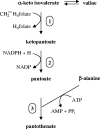Exogenous supply of pantoyl lactone to excised leaves increases their pantothenate levels
- PMID: 15767268
- PMCID: PMC4246761
- DOI: 10.1093/aob/mci114
Exogenous supply of pantoyl lactone to excised leaves increases their pantothenate levels
Abstract
Background and aims: All plants synthesize pantothenate but its synthesis and regulation are not well understood. The aim of this work is to study the effect of exogenous supply of precursor compounds on pantothenate levels in leaves.
Methods: Precursor compounds were supplied in solution to excised leaves and the pantothenate content was measured using a microbial method.
Key results: Pantothenate levels in excised leaves of Limonium latifolium, tomato (Lycopersicon esculentum), bean (Phaseolus vulgaris) and grapefruit (Citrus x paradisi) were examined following an exogenous supply of the precursor compounds pantoyl lactone or beta-alanine. Significantly higher levels of extractable pantothenate were found when pantoyl lactone was supplied, but not when beta-alanine was supplied despite a measurable uptake of beta-alanine into the leaf.
Conclusions: The results suggested that the pantoate supply may be rate-limiting or regulating pantothenate synthesis in leaves.
Figures



Similar articles
-
Pantothenases from pseudomonads produce either pantoyl lactone or pantoic acid.Biochem J. 1988 Mar 1;250(2):447-51. doi: 10.1042/bj2500447. Biochem J. 1988. PMID: 3128283 Free PMC article.
-
Pantothenate auxotrophy of Methylobacterium spp. isolated from living plants.Biosci Biotechnol Biochem. 2019 Mar;83(3):569-577. doi: 10.1080/09168451.2018.1549935. Epub 2018 Nov 26. Biosci Biotechnol Biochem. 2019. PMID: 30475153
-
The final step of pantothenate biosynthesis in higher plants: cloning and characterization of pantothenate synthetase from Lotus japonicus and Oryza sativum (rice).Biochem J. 1999 Aug 1;341 ( Pt 3)(Pt 3):669-78. doi: 10.1042/0264-6021:3410669. Biochem J. 1999. PMID: 10417331 Free PMC article.
-
Active site residues in Mycobacterium tuberculosis pantothenate synthetase required in the formation and stabilization of the adenylate intermediate.Biochemistry. 2004 Jun 8;43(22):7171-8. doi: 10.1021/bi049676n. Biochemistry. 2004. PMID: 15170354
-
Pantothenate utilization by Plasmodium as a target for antimalarial chemotherapy.Infect Disord Drug Targets. 2010 Jun;10(3):200-16. doi: 10.2174/187152610791163390. Infect Disord Drug Targets. 2010. PMID: 20334619 Review.
Cited by
-
Pantothenate synthetase is essential but not limiting for pantothenate biosynthesis in Arabidopsis.Plant Mol Biol. 2008 Jan;66(1-2):1-14. doi: 10.1007/s11103-007-9248-6. Epub 2007 Oct 12. Plant Mol Biol. 2008. PMID: 17932772
References
-
- Brown GM, Williamson JM. 1987. Biosynthesis of folic acid, riboflavin, thiamine, and pantothenic acid. In: Neidhardt FC, ed. Escherichia coli and Salmonella typhimurium cellular and molecular biology, Vol. 1. Washington DC: American Society for Microbiology, 521–538.
-
- Falk KL, Guerra DJ. 1993. Coenzyme A biosynthesis in plants: partial purification and characterization of pantothenate kinase from spinach. Archives of Biochemistry and Biophysics 301: 424–430. - PubMed
-
- Gonthier A, Fayol V, Viollet J, Hartmann DJ. 1998. Determination of pantothenic acid in foods: influence of the extraction method. Food Chemistry 63: 287–294.
-
- Hoagland DR, Arnon DI. 1950. The water-culture method for growing plants without soil. California Agricultural Experiment Station Bulletin No. 347.

